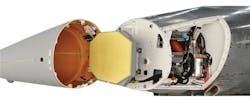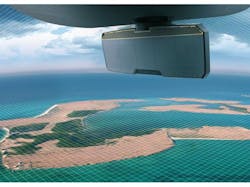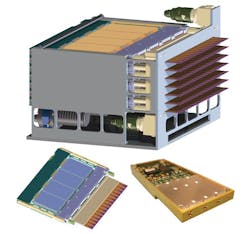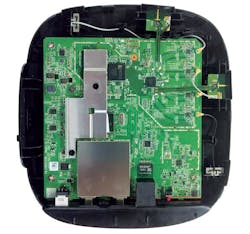AESAs Boost Multi-Role Capabilities for Warfighters, UAVs, and Wi-Fi
This file type includes high resolution graphics and schematics when applicable.
Both in the United States and across the globe, active electronically scanned array (AESA) radar is being increasingly recognized and adopted for its key features. For example, AESA technology provides the simultaneous detection, identification, and tracking of multiple air and surface targets. Compared to mechanically scanned arrays, it features up to 10× increased operational availability. In addition, its higher resolution leads to increased standoff range. Now, modular techniques and low-cost retrofit modules are beginning to surface for AESA technology. As a result, they are considered more viable for legacy warfighters while offering more application scalability (Fig. 1).
These cost-cutting and modular techniques also are prompting reviews of AESA technology for land, naval, and even commercial applications. For earlier generations of warfighters, passive phased-array radar brought a huge advance in electronic-warfare (EW) capability by allowing the radar to be steered with mechanical motors. To eliminate the need for such mechanical adjustments, AESAs rely on beam-forming and beam-steering technologies. The ability of these arrays to handle multi-role capabilities also has been enhanced due to the emergence of solid-state technologies, such as gallium nitride (GaN) and software-defined-radio (SDR) architectures.
Thanks to the advancement of wideband, solid-state electronics such as GaN power amplifiers (PAs), several fourth- and fifth-generation warfighters are now being equipped with AESAs. These retrofits are converting warfighters from a wide range of countries into multi-role-capable airframes—a major upgrade. In addition, these systems promise to provide increased mechanical reliability and lower maintenance costs, thereby decreasing the cost over time and downtime of warfighters. Generally, these devices are designed for a variety of aircraft and platforms as drop-in modules—a feature that brings repair and servicing closer to the field.
Low-Cost AESA Technology
As AESAs further their reach into retrofit applications, companies like BAE, Northrop Grumman, Raytheon, and others are increasing the lifetime of aging warfighter platforms. Prompting these retrofits are two factors: the decrease in available funding for the number of warfighters that are being demanded and the lower cost of AESA technology after the initial development and deployment. The investment in AESA also has been reduced as a result of advancing field-programmable gate arrays (FPGAs) and software-defined-radio (SDR) techniques (Fig. 2).
The latest AESA technologies also offer a dramatically reduced weight and size profile, which allows the radar to provide operational cost savings via payload reduction. These systems are small enough to be mounted on many unmanned-aerial-vehicle (UAV) platforms (Fig. 3). As a result of such enhancements, UAV warfighters are being planned by the U.S. Navy. There also is the possibility of making viable autonomy drop-in kits for helicopters and land vehicles. More potential applications will undoubtedly emerge, given AESA’s ability to operate as a traditional EW antenna while providing software control and programmability. In fact, these devices can operate as long-range and highly capable data links as well as high-resolution radar-imaging devices. They also operate over many different radar bands.
Modular AESA Platforms
In addition to ease of integration, scalable design has become one of the primary focus factors for recent AESA developments. As a result, a number of organizations are developing module-based AESA platforms constructed from a combination of multiple building blocks. This common-module approach increases the manufacturability of an AESA platform while lowering its cost and complexity barriers of entry. It also brings AESA technology closer to infiltrating satcom, data-link, weather, and air-traffic-control applications.
With the contract for phase one of the Arrays on Commercial Timescales (ACT) program, for example, the DARPA Microsystems Technology Office is attempting to merge enhanced AESA development with the commercial infrastructure. The project focuses on AESA platforms that are based on a digital common module. That module is reusable, highly integrated, and uses commercial CMOS IC technology. The current vision of the common module is a commercial system-on-a-chip (SoC) with integrated, high-speed digital-to-analog and analog-to-digital converters (DACs and ADCs). It is capable of direction sampling and RF signal creation well into the K-band (18 to 27 GHz). Nonlinear digital-signal-processing (DSP) algorithms may enable the dynamic range needed to implement such a system.
AESA technology will continue to advance. For example, recent European investment has led to the development of metamaterial enhancements to AESA radars. These enhancements reduce the cost and size of RF feeding networks, thereby minimizing the coupling between the radiating elements while mitigating the parasitic back/side-lobe radiation from edging effects. On the home front, Raytheon has developed a pod-based AESA radar jammer for the Navy that is essentially a high-powered SDR with networking capability. As EW continues to dominate the arms race, AESA technologies will benefit from innovations that could trickle back to telecommunications and satcom technologies.
This file type includes high resolution graphics and schematics when applicable.
Active Electronic Steering Meets MIMO Wi-Fi
This file type includes high resolution graphics and schematics when applicable.
The demand for reliable and high-throughput data links in the common household is increasing, given the growing presence of IEEE 802.11ac MIMO Wi-Fi, the ability for set-top boxes to stream wireless 4K video, and more. Until recently, active electronic antenna steering was mostly relegated to warfighter and electronic-warfare (EW) applications. Now, a solution from Ethertronics is promising to bring active steering to 5-GHz consumer antenna applications (see Fig. 4).
The solution comprises an advanced antenna architecture, RF integrated circuits (RFICs), and proprietary algorithms that enable—as a system—passive-to-active antenna conversion. In terms of flexibility, the solution can serve systems ranging from single antenna to 4×4 MIMO Wi-Fi. It promises to deliver data-rate improvements ranging from 15% to 45%, thanks to steering algorithms that track the locations of highest data demand.
For each antenna, the solution can produce four different radiation patterns. In other words, a 2×2 system will have eight different radiation patterns while a 4×4 system will have 16. Those radiation patterns optimize throughput to key locations. This self-configuring technology also can eliminate blind spots. In addition, it can increase range by sacrificing throughput over distance, solving a known issue for many 5-GHz systems in indoor environments. Because the switching pattern can adjust within 2 to 5 ms, even dynamic environments can be optimized.
The natural next step for this technology is to incorporate it into handhelds and other portable devices. According to trials with carriers and OEMs, it can deliver nearly a 30% to 45% improvement increase with a 4G LTE smartphone in field tests. GPS and automotive applications have already shown the potential for increased performance as well. Limited by the present switching technology, this solution is currently able to tackle applications from 700 MHz to 7 GHz. With more advanced switching technologies possibly opening the door for active steering for 5G prototypes, this technology demonstrates the viability of active steering in applications beyond EW and surveillance.
Another step to increase the viewing angle of these arrays is to mount the array at an angle on a rotating swashplate, essentially increasing the viewing at critical angles.
This file type includes high resolution graphics and schematics when applicable.





